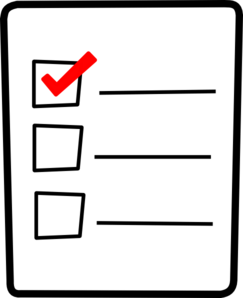The Self-Education Checklist
A while back I read a great book by Atul Gawande titled The Checklist Manifesto. The message of the book is that in today’s deluge of information and processes that many of us are required to utilize in our daily lives, and in our professional lives in particular, there is no way we can remember everything we need to do without a reference. That reference can be a simple checklist.
A checklist is simply a concise listing of steps or considerations that should be addressed as we undertake a task. I won’t go into the power that checklists have. Go ahead and read Gawande’s book to learn more about that, but the gist is that the introduction of a simple checklist into a task or process significantly improves the likelihood that all steps or considerations will be addressed and that the resulting outcome will be better. The evidence put forth by Gawande is irrefutable in this regard.
So, how might this apply to self-education? I’d like to propose you consider creating for yourself a simple checklist you can use to jumpstart any self-education effort you might undertake. As you begin to embark on a learning project, use each of these checklist items to hone and improve your learning. Each checklist item need only have one or a few words to queue you to thinking about the item. How you construct your checklist is up to you and should be tailored to your preferred ways of learning. Simple and short is usually best. This following checklist should give you some ideas.
- Start a learning document. This can be a simple word processing document that contains much of the content we’ll talk about in the remaining checklist. A learning document becomes your central repository for learning guidance and documentation of learning.
- What do I want to learn? At first glance, this seems like a silly checklist item, but too often we start to learn about something and realize we’ve failed to identify exactly what it is we want to learn?
- Why do I want to learn it? Why we want to learn something is important. Having a good reason to learn something motivates us and helps to keep our learning on track.
- What learning resources are available? Are there people you can communicate with who understand the topic? Books? Websites? eLearning? Discussion groups? Make as thorough a list of resources as possible.
- Can I identify some good overview material? Most of us learn best when we digest and understand high-level, overview material about the topic first. We hang the more detailed aspects of our learning on these larger, overarching ideas and concepts. Understanding them will improve your learning.
- Use the overview material. Learn from any overview material you can find until you feel you have a good, high-level understanding of the topic.
- Can I outline the topic? Creating an outline, even a rudimentary one, can assist you in organizing your thinking and your learning. No one will see the outline but you. So use whatever format works for you.
- What should I do and in what order? Identify some specific learning tasks such as reading a book, viewing a documentary, talking with a knowledgeable person, attending a speech or presentation, investigating a website, and so on.
- Act. You know what you want to learn, why you want to learn it, identified some resources, identified and learned from overview material, outlined the topic, and created an ordered list of learning tasks. Now it’s time to act and learn.
- Can I produce something that proves I know what I know? Can you create a document, presentation, video, photograph, audio recording, or anything else you can think of that “proves” you know the topic. This serves two purposes. First, it helps you solidify the learning that’s taking place as you create this product. Second, if you should ever need to prove to an employer or someone else that you know about this topic, such proof is incredibly valuable.
- Update, organize and store your learning document and any other materials you used to learn or prove your learning. Most of what you’ll be organizing are likely to be digital computer files, which are easily organized, but you might have some tangible physical stuff to deal with as well. When it becomes necessary to reference this stuff in the future, you’ll be glad you spent a little time doing this.
This checklist is just a suggestion for the creation of your own checklist. Adapt it to suit your needs. No one knows how you learn best better than you. And if you have any other suggestions for checklist items, please enter a comment to share with everyone so we can all keep learning.
